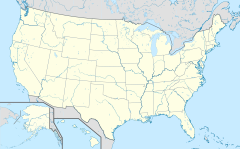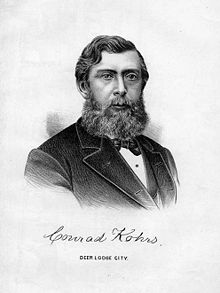Grant-Kohrs Ranch National Historic Site
| Grant-Kohrs Ranch National Historic Site | ||
|---|---|---|
| The ranch around 1880 | ||
|
|
||
| Location: | Montana , United States | |
| Next city: | Deer Lodge | |
| Surface: | 6.5 km² | |
| Founding: | August 9, 1972 | |
| Visitors: | 16,633 (2008) | |
The Grant-Kohrs Ranch National Historic Site is a National Historic Site- type memorial in the US state of Montana . It is reminiscent of the climax of the great cattle ranches in the Wild West , when the open range the cattle on public lands and the great cattle drives allowed. The ranch goes back to the Canadian fur trader Johnny Grant, it was bought by Conrad Kohrs in 1865 and subsequently expanded many times. Kohrs became known as the "cattle baron" and used the position of his company as the basis for a career in politics.
The ranch has been administered as a memorial by the National Park Service since 1972 , the operation as a cattle ranch continues and can be visited. In the summer half-year there are daily guided tours and living history demonstrations.
history
Kohrs, with full name Carsten Conrad Kohrs, born on August 5, 1835 in the Duchy of Holstein , first went to sea and stayed in Brazil, West Africa and Cuba. He became a citizen of the United States at the age of 22 in 1857 after trading cattle through relatives in Iowa and New York, selling sausages in New Orleans , shipping timber on the Mississippi and working in a distillery. Now he looked for gold in California , moved to Canada to the Fraser River and finally, still looking for gold, he came to Montana in 1862, where he worked as a butcher and sold meat to the prospectors. In 1864 he brought his half-brother John Bielenberg to Montana, later also his brother Karl (Charles).
In 1865 he bought Johnny Grant's small ranch and expanded the business. His herd of cattle grew rapidly, reaching up to 50,000 animals. He let his cattle graze on around 40,000 km² of public land where bison and plains Indians had previously lived. The bison had been almost exterminated by the 1840s and the Indians were forced into reservations . In 1868 he married Augusta Kruse, for whom he had the spacious ranch house built. The preserved furnishings of the house of an upper class family were brought together by her.
The Texan Longhorn cattle breed came north in the late 1870s . The meat breed was originally bred for the southern desert regions, but was also excellent for the poor soils of the northern prairies. By 1885, cattle breeding was by far the most profitable industry on the prairies. Kohrs Ranch sent per year, more than 10,000 animals in the Union Stockyards , the slaughterhouses of Chicago . Conrad Kohrs became known as Montana's Cattle King . He was also looking for new land in the north. West of Great Falls , he let his animals graze in the valleys of the Dearborn and Sun Rivers .

But even the additional resources of this region could no longer withstand overgrazing after a few years. During the harsh winter of 1886 to 1887, a third to half of the animals starved to death. In addition, the settlers, who built farms for arable farming under the Homestead Act , fought against the cattle grazing freely and even more against the cattle drives over the land they owned. The invention of barbed wire in 1873 and the increasing fencing of homesteads in the 1880s and 1890s ended the open range phase . Kohrs and Bielenberg changed the breeding methods and above all grew their own fodder and stored it as a supply when the times of free grazing came to an end, as the best pastures were taken and many areas were overgrazed. They also operated smaller mines in the countryside. Bielenberg also bred horses that were perfect for the cowboys' work .
Kohrs increasingly left the cattle business to his half-brother John and went into politics as a senator in the Montana Territory and, after the state was founded in 1889, in the US state of Montana . He was a co-founder of the Montana Stockgrowers Association , the professional association of cattle breeders.
In 1909 the ranch was still selling cattle for $ 500,000. In 1918, however, Kohrs sold his herds to a few hundred animals and only kept a few Shorthorn and Hereford copies. He died in 1920, John Bielenberg in 1922. The ranch was run by managing directors until it was taken over by Conrad Kohrs Warren, Kohr's grandson, during the Great Depression in 1932 . He rebuilt the cattle herd and also specialized the ranch in the breeding of first-class draft horses. After the Second World War he sold part of the land and the horse breeding. In the 1950s he switched to calf rearing and in 1972 sold the ranch to the federal government as a memorial to the history of the large herds of cattle in the Wild West.
The memorial
The ranch was registered as a National Historic Landmark in December 1960 and transferred to the federal government on August 9, 1972 and designated a National Historic Site . Around 90 buildings from all periods of the company are on the site. The National Park Service operates the company as a so-called working ranch , the cattle farm continues. In terms of area and number of visitors, the site is one of the National Park Service's small facilities.
Visitors can explore the site on their own or take a guided tour. The main house is largely furnished in the style of the late 19th century and can be visited. In the appropriate seasons, visitors can experience the processes on a cattle ranch from calving to nursing mothers and once a year the branding of some young animals. In the summer months, living history programs are offered, in which covered wagons , the mowing of meadows and drying of hay with historical tools or the ranch's blacksmith are demonstrated. Employees dressed as cowboys tell from the late Wild West and show visitors how the shepherds were on the move for weeks and months to drive the herds from the large open pastures together and then to the railroad, from where the herds to the big cities, especially Chicago, were transported.
Web links
- National Park Service: Grant-Kohrs Ranch National Historic Site (official site; English)
- National Park Service: Grant-Kohrs Ranch - Historic Resource Study on the history of the ranch in operation and as a memorial.
Individual evidence
- ↑ Listing of National Historic Landmarks by State: Montana. National Park Service , accessed August 16, 2019.




